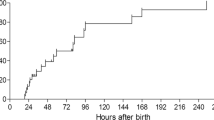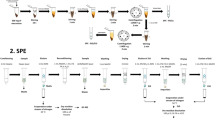Abstract
Alcohol consumption during pregnancy is a widespread problem and can cause severe fetal damage. As the diagnosis of fetal alcohol syndrome is difficult, the implementation of a reliable marker for alcohol consumption during pregnancy into meconium drug screening programs would be invaluable. A previously published gas chromatography mass spectrometry method for the detection of fatty acid ethyl esters (FAEEs) as alcohol markers in meconium was optimized and newly validated for a sample size of 50 mg. This method was applied to 122 cases from a drug-using population. The meconium samples were also tested for common drugs of abuse. In 73 % of the cases, one or more drugs were found. Twenty percent of the samples tested positive for FAEEs at levels indicating significant alcohol exposure. Consequently, alcohol was found to be the third most frequently abused substance within the study group. This re-validated method provides an increase in testing sensitivity, is reliable and easily applicable as part of a drug screening program. It can be used as a non-invasive tool to detect high alcohol consumption in the last trimester of pregnancy. The introduction of FAEEs testing in meconium screening was found to be of particular use in a drug-using population.




Similar content being viewed by others
References
ElSohly MA, Stanford DF, Murphy TP, Lester BM, Wright LL, Smeriglio VL, Verter J, Bauer CR, Shankaran S, Bada HS, Walls HC. Immunoassay and GC-MS procedures for the analysis of drugs of abuse in meconium. J Anal Toxicol. 1999;23:436–45.
Lopez P, Bermejo AM, Tabernero MJ, Cabarcos P, Alvarez I, Fernandez P. Cocaine and opiates use in pregnancy: detection of drugs in neonatal meconium and urine. J Anal Toxicol. 2009;33:351–5.
Marin SJ, Coles R, Urry FM, McMillin GA. Confirmation of cannabinoids in meconium using two-dimensional gas chromatography with mass spectrometry detection. J Chromatogr B Analyt Technol Biomed Life Sci. 2007;858:59–64.
Marin SJ, Merrell M, McMillin GA. Drugs of abuse detection in meconium: a comparison between ELISA and biochip microarray. J Anal Toxicol. 2011;35:40–5.
Dyckmans M. Drogen- und Suchtbericht M. Dyckmans, The German Federal Ministry of Health. Die Drogenbeauftragte der Bundesregierung: Berlin; 2011.
Manning MA, Hoyme HE. Fetal alcohol spectrum disorders: a practical clinical approach to diagnosis. Neurosci Biobehav Rev. 2007;31:230–8.
Gareri J, Klein J, Koren G. Drugs of abuse testing in meconium. Clin Chim Acta. 2006;366:101–11.
Bakdash A, Burger P, Goecke TW, Fasching PA, Reulbach U, Bleich S, Hastedt M, Rothe M, Beckmann MW, Pragst F, Kornhuber J. Quantification of fatty acid ethyl esters (FAEE) and ethyl glucuronide (EtG) in meconium from newborns for detection of alcohol abuse in a maternal health evaluation study. Anal Bioanal Chem. 2010;396:2469–77.
Gareri J, Lynn H, Handley M, Rao C, Koren G. Prevalence of fetal ethanol exposure in a regional population-based sample by meconium analysis of fatty acid ethyl esters. Ther Drug Monit. 2008;30:239–45.
Hutson JR, Rao C, Fulga N, Aleksa K, Koren G. An improved method for rapidly quantifying fatty acid ethyl esters in meconium suitable for prenatal alcohol screening. Alcohol. 2011;45:193–9.
Moore C, Jones J, Lewis D, Buchi K. Prevalence of fatty acid ethyl esters in meconium specimens. Clin Chem. 2003;49:133–6.
Kwak HS, Kang YS, Han KO, Moon JT, Chung YC, Choi JS, Han JY, Kim MY, Velazquez-Armenta EY, Nava-Ocampo AA. Quantitation of fatty acid ethyl esters in human meconium by an improved liquid chromatography/tandem mass spectrometry. J Chromatogr B Analyt Technol Biomed Life Sci. 2010;878:1871–4.
Klein J, Karaskov T, Korent G. Fatty acid ethyl esters: a novel biologic marker for heavy in utero ethanol exposure: a case report. Ther Drug Monit. 1999;21:644–6.
Pichini S, Marchei E, Vagnarelli F, Tarani L, Raimondi F, Maffucci R, Sacher B, Bisceglia M, Rapisardi G, Elicio MR, Biban P, Zuccaro P, Pacifici R, Pierantozzi A, Morini L. Assessment of prenatal exposure to ethanol by meconium analysis: results of an Italian multicenter study. Alcohol Clin Exp Res. 2012;36:417–24.
Morini L, Marchei E, Pellegrini M, Groppi A, Stramesi C, Vagnarelli F, Garcia-Algar O, Pacifici R, Pichini S. Liquid chromatography with tandem mass spectrometric detection for the measurement of ethyl glucuronide and ethyl sulfate in meconium: new biomarkers of gestational ethanol exposure? Ther Drug Monit. 2008;30:725–32.
Auwärter V. Fettsäureethylester als Marker exzessiven Alkoholkonsums—Analytische Bestimmung im Haar und in Hautoberflächenlipiden mittels Headspace-Festphasenmikroextraktion und Gaschromatographie-Massenspektrometrie. Dissertation. Institute of Legal Medicine and Forensic Sciences. Humbold University Berlin; 2006. http://edoc.hu-berlin.de/dissertationen/auwaerter-volker-2006-01-20/PDF/auwaerter.pdf.
Burd L, Hofer R. Biomarkers for detection of prenatal alcohol exposure: a critical review of fatty acid ethyl esters in meconium. Birth Defects Res A Clin Mol Teratol. 2008;82:487–93.
Chan D, Bar-Oz B, Pellerin B, Paciorek C, Klein J, Kapur B, Farine D, Koren G. Population baseline of meconium fatty acid ethyl esters among infants of nondrinking women in Jerusalem and Toronto. Ther Drug Monit. 2003;25:271–8.
Ostrea EM Jr, Hernandez JD, Bielawski DM, Kan JM, Leonardo GM, Abela MB, Church MW, Hannigan JH, Janisse JJ, Ager JW, Sokol RJ. Fatty acid ethyl esters in meconium: are they biomarkers of fetal alcohol exposure and effect? Alcohol Clin Exp Res. 2006;30:1152–9.
Bearer CF, Jacobson JL, Jacobson SW, Barr D, Croxford J, Molteno CD, Viljoen DL, Marais AS, Chiodo LM, Cwik AS. Validation of a new biomarker of fetal exposure to alcohol. J Pediatr. 2003;143:463–9.
Pichini S, Pellegrini M, Gareri J, Koren G, Garcia-Algar O, Vall O, Vagnarelli F, Zuccaro P, Marchei E. Liquid chromatography-tandem mass spectrometry for fatty acid ethyl esters in meconium: assessment of prenatal exposure to alcohol in two European cohorts. J Pharm Biomed Anal. 2008;48:927–33.
Hutson JR, Aleksa K, Pragst F, Koren G. Detection and quantification of fatty acid ethyl esters in meconium by headspace-solid-phase microextraction and gas chromatography-mass spectrometry. J Chromatogr B Analyt Technol Biomed Life Sci. 2009;877:8–12.
Chan D, Klein J, Karaskov T, Koren G. Fetal exposure to alcohol as evidenced by fatty acid ethyl esters in meconium in the absence of maternal drinking history in pregnancy. Ther Drug Monit. 2004;26:474–81.
Moore C, Negrusz A, Lewis D. Determination of drugs of abuse in meconium. J Chromatogr B Biomed Sci Appl. 1998;713:137–46.
Peters FT, Herbold M. Society of toxicological and forensic chemistry (GTFCh)—Anforderungen an die Validierung von Analysenmethoden. Toxichem Krimtech. 2009;76:185–208.
Grubbs F. Procedures for detecting outlying observations in samples. Technometrics. 1969;11:1–21.
Cochran WG. The distribution of the largest of a set of estimated variances as a fraction of their total. Ann Eugen. 1947;11:47–61.
Mandel J. The statistical analysis of experimental data. New York: Wiley; 1964.
DIN 32645. Chemical analysis—decision limit and determination limit under repeatability conditions—terms, methods, evaluation. Berlin: Beuth Verlag; 2008.
Funk W, Dammann V, Donnevert G. Qualitätssicherung in der Analytischen Chemie. Weinheim: Wiley-VCH; 1992.
NQSZ. General requirements for the competence of testing and calibration laboratories (ISO/IEC 17025:2005); German and English version EN ISO/IEC 17025:2005, 2005, DIN Deutsches Institut für Normungen e. V.
Shor S, Nulman I, Kulaga V, Koren G. Heavy in utero ethanol exposure is associated with the use of other drugs of abuse in a high-risk population. Alcohol. 2010;44:623–7.
Susse S, Selavka CM, Mieczkowski T, Pragst F. Fatty acid ethyl ester concentrations in hair and self-reported alcohol consumption in 644 cases from different origin. Forensic Sci Int. 2010;196.
Acknowledgments
Dr. René Gapert’s stay at the Institute of Legal Medicine and Forensic Sciences in Berlin was supported by a DAAD Research Scholarship (Deutscher Akademischer Austausch Dienst—German Academic Exchange Service Research Grant A/11/75955).
Conflict of interest
None.
Sample collection and origin
All data was anonymized before evaluation. This data was collected as part of a study approved by the Ethics Committee of the Charité—University Hospital Berlin (Code EA4/048/10).
Author information
Authors and Affiliations
Corresponding author
Rights and permissions
About this article
Cite this article
Hastedt, M., Krumbiegel, F., Gapert, R. et al. Fatty acid ethyl esters (FAEEs) as markers for alcohol in meconium: method validation and implementation of a screening program for prenatal drug exposure. Forensic Sci Med Pathol 9, 287–295 (2013). https://doi.org/10.1007/s12024-012-9385-3
Accepted:
Published:
Issue Date:
DOI: https://doi.org/10.1007/s12024-012-9385-3




